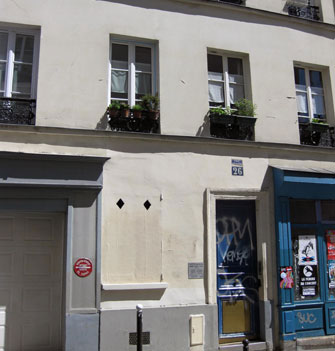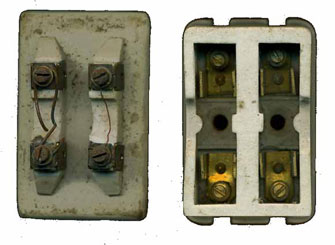
It’s not easy to find a rental apartment in Paris. Real estate here is a permanent seller’s market—there is never enough housing for all the people who want to live in town. Ask any couple who has a decent apartment in Paris how they got the place and the answer will invariably be a long story beginning with these words: “We were so lucky!”
So how did Nancy and I find our first Paris apartment? We were so lucky! The market may be different now, but in the early ’80s, when we decided to move in together, there were very few “flat for rent” ads. The daily newspaper Le Figaro was considered the best source, in the sense that it had about two dozen per day for the entire city of 2.5 million people.
Some of the ads would give a phone number, which was a waste of ink—the line would be perpetually busy due to the flood of calls. Landlords with any experience would just give the address and announce a time to come and view the apartment. And in this context “view” means “beg, bribe or extort the owner to pick you over the other 1,000 applicants and then maybe have a quick glance around.”
After about two weeks of fruitless searching, we saw a notice in the Figaro for a small, affordable place in a part of Montmartre that we liked, to be open for viewing at 11am the following Saturday. The ad mentioned that the flat was on the fifth étage (sixth floor in American terms), so when we arrived at 10:30 that Saturday we were dismayed, although not exactly surprised, to see that the line had already filled the entire stairway and was spilling out into the street.
We waited for about two hours, slowly snaking our way up the stairs in the close air, until finally it was our turn to meet the owners. They liked us (we were so lucky!), I think because we seemed to embody all of the qualities that a French landlord looks for in a tenant: personable, responsible, solvent and, most importantly, not French.
This may seem odd, but French owners like non-French renters because it’s almost impossible to evict a deadbeat tenant here—foreigners are presumed to be, for one thing, less likely to know that and, for another thing, more likely to want to move out someday.
Long and lucky story short, they picked us out of the hundreds of hopefuls, and shortly thereafter we moved into our 30-square-meter (about 320-square-foot) one-room Montmartre apartment. The rent was 2,400 francs a month—about €360.
I have fond memories of the place, because it was our first home together, because we loved the neighborhood (which I mentioned in a previous C’est Ironique), because we had a long narrow balcony with a sweeping view of Paris, and because I happened to notice one day that I could look directly from our kitchen window into the shower of the attractive young lady in 4D. But the building itself was a wreck.
It should have been demolished years before. Literally: I learned later that the entire neighborhood had been built in the mid-19th century to house the Italian masons who were brought in to build the fancy stone buildings in the center of town. The latter were built to last, but the wood and plaster (i.e. one architectural notch up from stick and mud) houses like ours were originally intended to have a lifespan of 20 to 30 years.
But there they still were, and are to this day, nearly two centuries later. And not in good shape—or at least ours certainly wasn’t. There was a major building-wide plumbing problem at least once a month, requiring the water to be cut off without warning, usually just as I was about to rinse the shampoo out of my hair.
The heating system, which relied on hot water circulating through an old, noisy, decrepit gas heater that was fond of breaking down and even fonder of releasing carbon monoxide, was not up to the task of keeping the place warm in the winter. Frost would form on the inside of the windows, and on one memorable January morning I awoke to find the water in the toilet frozen solid. Fortunately I had a fair supply of organic de-icing fluid on hand, so to speak, to help thaw it out.
But what really got me was the electrical system. At a guess, I would say that our apartment had been electrified at about the same time that Josephine Baker was electrifying audiences at the Folies Bergère. And Miss Baker’s system for delivering a charge was much the superior.
Our “fuses” were of an old-fashioned kind that I sincerely hope is now illegal: oblong porcelain plugs that fit into slots in an overhead box by the door. The slots had copper contacts inside that contacted two pairs of screws on each plug, between which ran a bare wire.
That wire was the fuse: it was made of a special kind of tin that would burn and burst if the circuit was overloaded. Which, especially since we only had two plugs for the entire apartment, was all the time.
The plugs and slots looked like this:

It was still possible to buy spools of the cut-it-yourself wire in hardware stores. On the package it said, in big bold red type:
WARNING! Wrap ONLY ONE length of wire between the terminals. DO NOT double the wire. DANGER OF SHOCK! DANGER OF FIRE! DANGER OF DEATH! DANGER OF DIVINE RETRIBUTION! DANGER OF NEVER GETTING LAID AGAIN! … etc., etc.
So, naturally, the first thing I learned was that a single length of wire would blow out instantly upon being reinserted in the slot. The only alternative to reading by candlelight and cooking in the fireplace was to wrap not just two but multiple layers of wire between the screws, and even then the circuit would cede at the slightest hint of an overload. We couldn’t make toast with the TV on, and I had to make an effort not to think while running the vacuum cleaner—if I had an idea, the light bulb over my head would blow the fuse.
And that’s not even the worst part. Get this: in our apartment, the wires had burned out so many times over so many decades that the screw threads inside the plugs were completely filled in with melted fuse-wire metal, which meant that the screws would fall out instantly unless the plug was held horizontally.
But to go into the slot, the plug had to be held vertically. So to “change a fuse” I had to take the plug out, pick up the screws from the floor, where they would inevitably fall, put them gingerly back in place, wrap way too many lengths of wire between them, and then slam-dunk the plug back into its slot as fast as possible, praying that none of the four screws would slip out along the way. The frequency with which my prayers were answered has a lot to do with my atheist leanings today.
And speaking of answers to cosmic questions, no, it was not possible to buy new porcelain plugs—I asked everywhere.
Still, we never had an electrical fire (we were so you-know-what!). And we were never burglarized, even though the building had no intercom or security code, so anyone could walk in at any time. And in this context, “anyone” means “felons” and “at any time” means “at any time.” One night, someone did try to pry our flimsy, non-armored door open with a crowbar, but the thief gave up before the lock did (WWSL!).
The constant threat of electrocution and garret invasion notwithstanding, I felt lucky to have found that place. We stayed for five years, at the end of which I realized just how lucky we had been all along (cue timpani roll… no, wait—the cello riff from Jaws).
There was one neighbor just downstairs from us whom I never talked to other than to say bonjour in the stairway. He was a taciturn middle-aged guy who always, always, always, always (which in this context means “always”) had a cigarette in his mouth and was almost always very obviously very drunk. Sometimes I was, too, but we’re talking about the neighbor here.
Shortly before Nancy and I moved out, I happened to get a glimpse of his apartment for the first time. He had left the door open for some reason as I was coming down the stairs, and I glanced in. And saw that the entire place—not just the entryway but every space that I could see—was filled with floor-to-ceiling stacks of old newspapers.
He was a compulsive hoarder! And, worse, a compulsive newspaper subscriber!
Then it dawned on me: we had been living for five years on the top floor of a dilapidated building with faulty wiring, no fire escape and often no water, just upstairs from a chain-smoking drunkard whose hobby was surrounding himself with kindling. Stop me if you’ve heard this one before, but we were so lucky!
Lucky to get into the place, and lucky to get out of it alive.
Household tip:
Here’s a little something that I learned from my old apartment: mice, or at least Montmartre mice, are not especially fond of cheese (traitors!) but cannot resist pita bread. I don’t like to think about how I acquired this morsel of practical wisdom. On the other hand, we never had cockroaches. So once again, we were lucky. The mice, not so much.
© 2012 Paris Update
FavoriteAn album of David Jaggard’s comic compositions is now available for streaming on Spotify and Apple Music, for purchase (whole or track by track) on iTunes and Amazon, and on every other music downloading service in the known universe, under the title “Totally Unrelated.”
Note to readers: David Jaggard’s e-book Quorum of One: Satire 1998-2011 is available from Amazon as well as iTunes, iBookstore, Nook, Reader Store, Kobo, Copia and many other distributors.
